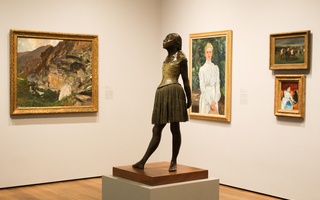Twice Born: Beauty overwhelms. The styles represented range from naturalism to pure abstraction and the show's dimensions-12 artists by 3 rooms by 46 pieces-are enormous. There are big, colorful chunks, symmetrical and impassive, alongside incredibly detailed works with careful touches of color and fine line. The show holds itself together with an explicit appeal to the pursuit of beauty, to its indefinable, essential meaning in art. But isn't this intuitive when we talk about art? Isn't art, in some fundamental way, about beauty that gives us pleasure, heightens our senses, or transports us?
Yes-but maybe we have forgotten. Grasping the essential character of the beautiful has long been the object of philosophical and theoretic interest and finds expression through this exhibit's formalist regard. In recent years, there has been a revival of aestheticism; witness the Regarding Beauty exhibition last year at the Hirshhorn. Recent literary investigations also suggest an atmosphere of palpable eagerness to explore beauty topically. The revival is a kind of return to beauty for art's sake, liberated from any service or subordination to a social or political climate of interpretation.
Yet Twice Born: Beauty does carry a larger message, an interest in the quality of beauty and its identification. The aesthetic concern, however, hardly seems of a piece with other theoretical frameworks. Twice Born: Beauty tries for a ground-zero approach to art appreciation, asking for intuitive criteria available to the sensitive viewer. The project supports no suggestion of direct artistic inheritance. The normative criteria of Western, Eastern and other traditions are collapsed into formal abstract principles: "unity, variation in unity, complexity, intensity, brightness or clarity, harmony or coherence, and resolution." There is a pressure to seek universals.
Shelly Bancroft, who curated the show, says that she wanted "to do a show that's not ironic about beauty...to establish some criteria that would be objective and also allow subjectivity to come into play." Perhaps the universal character is to be found in the variable connections most of the pieces make with naturalism. Views out of windows onto snow-laden trees, seagulls in blue skies and golden-brown seascapes offer images that arrest the eye, full of kinesthetic suggestion and opportunity for sensation.
This exhibition directs its viewers to a precedent, the "ideal." The title Twice Born: Beauty is taken from one of Hegel's lectures on aesthetics called "Born of the Spirit and Born Again." In this lecture, he writes that the "forms of art, as the actualizing and unfolding of the beautiful, find their origin in the Idea itself...The consummation of the Idea as content appears therefore simultaneously as also the consummation of form."
This critical connection between the "Idea" or artistic visualization and its materialization in "form" is important for the analytic sensibility of the exhibition. Enlisting a work of art for a cause, arguably outside the field of the discrete work, seems to make it easier to cut out the artist, to make the art stand for something else. Directly opposing that kind of conception, the emphasis on the creative act recalls the artist. The exhibit emphasizes that art is crafted. As for the analytic sensibility, coupling the artist with the art serves to isolate the identity of the work.
So what happens when the proverbial beholder turns his eye on the artist's intention? The emphasis seems altogether independent from distinguishing "beauty" in its transcendent character. This antinomy, premised on beauty's universality, with its divergent conclusions about art, comes across in the exhibit's presentation as the tension between objectivity and subjectivity.
Titles in this show conspicuously, though ostensibly coincidentally, refer to a consciousness or mental presence. Emily Cheng's "The Most Violent of all Pleasures" and Heather Hobler-Keene's "Memory of Lost Thought" presuppose the Hegelian "Idea." Adding a gloss of abstraction, they are not merely descriptive. Yet there are no titles or names on the gallery walls, defying the instinct to seek verbal direction.
Read more in Arts
THIS WEEKEND IN THEATERRecommended Articles
-
Appleton Chapel.Rev. M. S. C. Wright spoke at Appleton Chapel last night, taking for his text the verse: "Yea, the sparrow
-
University CalendarSaturday, November 6. **MORNING PRAYER. Rev. H. S. Nash, D.D. Appleton Chapel, 8.45 A. M. FACULTY OF MEDICINE. Meeting at
-
Dr. Kallen's First Lecture TodayDr. H. M. Kallen '03, of the Department of Philosophy, will give the first of his series of seven lectures
-
University CalendarSaturday, November 27. **MORNING PRAYERS. Rev. P. R. Frothingham. Subject: "The Mystery of Faith." Appleton Chapel, 8.45 A. M. Sunday,
-
 Beauty and the Brain: The Emerging Field of Neuroaesthetics
Beauty and the Brain: The Emerging Field of Neuroaesthetics













